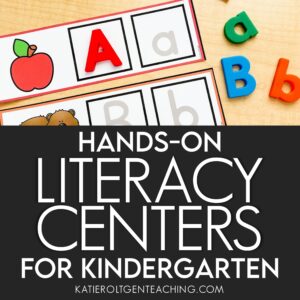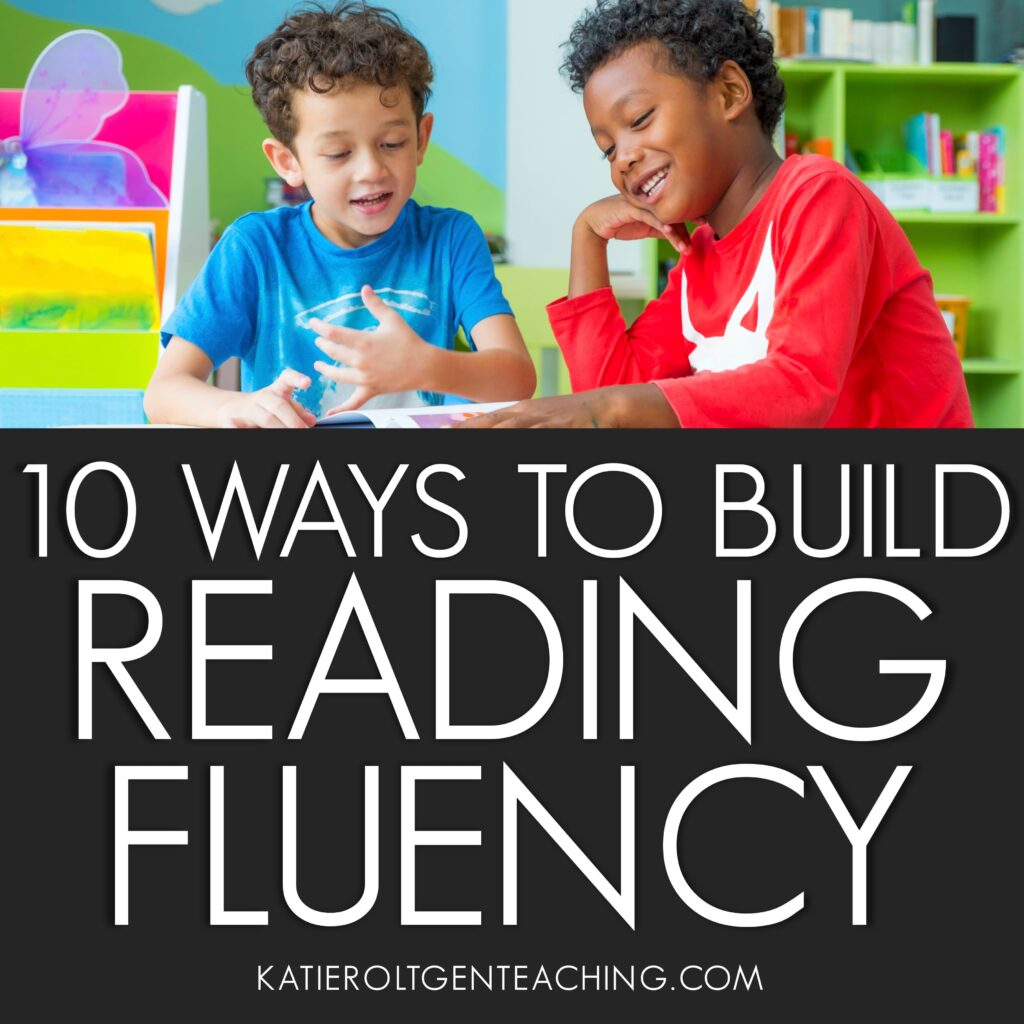
Menu
Reading fluency for kids means being able to read a book or text accurately, at a good pace and with feeling and emotion in their voice (we call this inflection.)
When a reader is fluent, they don’t need to stop and figure out every single word, which lets them focus on what the story is all about. Fluency is like a bridge that connects understanding words to understanding the whole story!
Increasing a student’s reading fluency is one of the most important things we can do as teachers!
Are you looking for some fun and engaging fluency activities for kindergarten? You have come to the right place! Let’s check out some easy ways to build fluency skills in your classroom!

Reading fluency, the ability to read smoothly with proper expression and pace, holds significant importance in a child’s reading journey.
When a child achieves fluency, they have an easier time not only decoding individual words but also understanding the meaning behind them. Fluent reading is like a bridge that connects various reading skills; it enhances a child’s reading comprehension by allowing them to focus less on decoding and more on understanding the text’s meaning. So essentially, having good reading fluency overall will help a child’s reading comprehension. When students can read a sentence or passage fluently and comprehend it, then reading actually becomes enjoyable for them! Isn’t that our goal as teachers?! That our students love to read and find it enjoyable?
There are three components that help build a strong foundation for a fluent reader:
Alright, accuracy is a big deal in reading fluency. When you’re an accurate reader, it means that you can read words without stumbling or needing a lot of help. And when you’re good at reading those words spot-on, it helps you understand what you’re reading way better. Instead of getting stuck on words, you can focus more on what the whole story or passage is trying to tell you. (so you are improving your reading comprehension!)
So, speed in reading isn’t just about racing through pages. Being a fluent reader isn’t about being the fastest; it’s about finding the right pace and going the appropriate speed. It’s like driving on a road— not too slow that you’re holding up traffic (or your understanding), and not too fast that you miss the sights (or the meaning of the text).
A good reader keeps a pace that fits the story that they are reading. Having automatic word recognition for sight words and being able to quickly decode CVC words will help with this part of fluency.
Expression is like adding some flavor to your reading. It’s about putting some feeling into the words. When you read expressively, you’re not just saying the words; you’re giving them life. You pause at the right places, change your voice for different characters and use stress to highlight important words or phrases.
Expressing yourself while reading makes it more fun and helps others understand what you’re reading way better. This can be difficult to teach kindergartners and young students. The best way to teach expression is through modeling through read aloud stories.
Below are 10 meaningful ways to build reading fluency with kindergarten students.
This first idea may come as a no-brainer idea to some of you but I still think it needs to be said! When kids know their letters and the sounds they make, then they will have a very strong base to begin their reading journey.
Knowing the alphabet helps students quickly recognize words, understand letter sounds and spot similarities between different words. Having this alphabet letter knowledge will make reading go faster and smoother (we all want that, right?!)
Basically, once kindergartners are familiar with the alphabet and feel confident with letter and sound recognition, they can then more easily put letters together to make words! (aka…become more fluent!)
The Alphabet Activities Mega Bundle will help make sure that your students know the letters by the end of first quarter with over 600 pages of fun alphabet activities!
This Roll and Read BUNDLE for CVC words has 75 no-prep pages with decodable sentences that make teaching reading easy for you and fun for your students!
These simple sight word write and read pages are a fantastic way to provide additional support for sight word knowledge for kindergarteners! On each page, students will write the sight word on the blank space in each sentence. Then they can read the sentences.
Differentiated Sight Word Practice for your Kindergarten Classroom:
There are two different ways you can use this sight word worksheet: one with blank spaces for the sight words and one with traceable sight words. You can pick which version best fits your students’ needs.
Echo reading or choral reading simple sentences is another great way of building fluency for early readers. The CVC Bundle Decodable Passages are really great for this because they have many common sight words in them.
This is another fun activity to try in your kindergarten classroom. Pair students up and have them take turns reading to each other. Provide simple, engaging books (like these easy emergent readers) or stories that match their reading level.
Encourage them to read aloud to their buddy, helping each other with tricky words. This activity not only helps improve fluency but also fosters a love for reading and teamwork among young learners.
These easy readers are perfect for younger students working on high frequency words or sight words. Practicing sight words and high-frequency words is a great way to help students become more fluent in their reading!
You can use these in a whole group or small group setting. To make it more fun, I would let students use a different color to highlight the sight word that we were practicing that day. Some days, I might tell them to get out a yellow hi-liter, sometimes it might be a green crayon or a purple marker.
When we practiced reading these printable books, I would typically have students choral read with me to make sure everyone understood what the book said.
Rhyming is a literacy skill that really helps children understand the concept of word families. Once they see and hear the words that rhyme, they slowly begin to look at the patterns in the words and understand that if they can read a word like hat then they can read the word mat. Incorporating rhyming activities and poems during whole group time will definitely help increase kindergartener’s fluency skills.
Building cvc words and words in the same word family are a great activity to try during small group instruction to help students increase their fluency skills. You can find tons of magnetic letter building activities inside the Morning Tubs Bundle!
This is a fun and simple game to try! Give students short decodable sentences or sight words and see how many they can read before the timer runs out!! I like to use little sand timers like this one they can see a visual example of the timer.
This one might seem silly but it works! Model how NOT to read a sentence so your students can understand the true meaning of fluency and why it is important! Modeling the wrong way to read serves as an effective technique for teaching fluency to kindergartners by fostering critical thinking and learning. By intentionally showcasing errors in reading—like mispronunciations, lack of expression, or a slow reading pace—children become more attentive to what doesn’t sound accurate. Encouraging them to pinpoint these mistakes helps with active participation and then we discuss how to make it better.

One of my biggest tips for starting to work on fluency with kindergarten students is to remember that everyone will learn this literacy skill at their own pace. Starting with favorite books that students love is smart because they will be excited to read it over and over. This is an effective tool for gaining their interest in this skill!
In wrapping up, practicing fluency is like a key step on the path to becoming an amazing reader. It’s clear that emphasizing fluency practice in our teaching is a game-changer for our students’ reading journey! When we provide our students with fun and engaging ways to practice fluency, then they will be all in!
Fluency is the gateway to comprehension and a lifelong love of reading. Let’s continue to prioritize these practices in our classrooms, supporting each other and our students on their path to becoming exceptional readers. Together, let’s keep nurturing fluency—it’s a catalyst for their reading success!
What other fluency activities and tips do you have for kindergarten?